Mitigation of DC Components Using Adaptive BP-PID Control in Transformless Three-Phase Grid-Connected Inverters
Abstract
1. Introduction
- (1)
- DC component suppression inverters. This approach does not change the power circuit topology, and an additional sampling circuit is adopted. In this research area, Sharma first introduced a dc component voltage detection method [17]. A small 1:1 voltage transformer and an RC circuit were used to detect the dc component voltage at the inverter output in the full-bridge grid-connected inverter. The dc component in the grid current was eliminated by feeding back the dc component voltage to the PI controller, yet, this method needs an additional voltage transformer, which will make the hardware system more complex. Alfock and Bowtell continued studying this method by establishing and verifying a mathematical model [18]. He and Xu used a voltage sensor at the inverter output consisting of a differential amplifier and a low-pass filter. DC component detected at the output of the low-pass filter is fed back to the controller. However, experimental results under grid-connected mode were not given. The voltage-detection control method uses sensors to detect the dc component across the ripple filter [19], this method ensures that a very low dc component voltage across the filter, which is sensitive to noise, is measured. Buticchi proposed another dc component detection method [20], however, this method needs a nonlinear inductor. Hence, a customized inductor should be designed according to specific systems.
- (2)
- Detection and compensation methods. Guo et al. developed a method to block dc components by using a virtual capacitor [21,22]; however, the dynamic response of the closed-loop control system was affected by the virtual capacitors. The method of applying inverter topology with dc component suppression ability uses inherent structure of the inverter topology, which can prevent dc components from injecting into the grid, e.g., the half-bridge inverter. However, few practical topologies exist. The method of current-detection control uses current sensors to detect the dc component injection, but its effectiveness is limited by the accuracy of sensor due to the inherent significant zero-drift characteristic of Hall-effect current sensors. To solve the zero-drift problems, an auto-calibrating inverter has been proposed by Armstrong [23]. However, this method requires determining the switch state of the H-bridge to measure the inherent zero-drift of the system.
- (3)
- (4)
- Using an isolation transformer. This is the simplest way which allows the galvanic isolation and voltage level regulation, yet, the additional fundamental transformer could produce an increase on the inverter’s final cost, moreover, its efficiency is reduced, and it is bulky and heavy [26].
- (1)
- The influences that will lead to dc components in the grid-connected system are analyzed, including turn-ON/-OFF time-delay, imparities of power transistors, unbalanced grid voltage, scaling errors of sensors.
- (2)
- Different from conventional dc component suppression methods, in this paper, to effectively and timely minimize the dc components in the grid, an adaptive back-propagation BP-PID controller is presented, in which, coefficients of PID controller are adaptively regulated on-line by the output of the BP controller. The proposed scheme combines the merits of two controllers, which show better performance in robustness, self-learning capability, and fast time response.
- (3)
2. Impacts of Time-Delay, Scaling Errors of Sensors, Unbalanced Voltage on Grid Current Performance
2.1. DC Component Injection Analysis
2.2. DC Component Injection Due to Gate-Driving Delays
2.3. DC Component Analysis Due to Zero-Drift and Scaling Error of Current and Voltage Sensors
2.4. DC Component Analysis Due to the Asymmetries of Power Transistors
2.5. DC Component Analysis Due to Unbalanced Grid Voltage
2.6. DC Component Extraction Algorithm Using SWDIM
3. Proposed DC Component Suppression Scheme with Adaptive BP-PID Controller
3.1. DC Component Suppression Scheme with Adaptive BP-PID Control
- (1)
- DC component extraction method using double integrations. This block is used for fast dc component extraction.
- (2)
- Adaptive BP neural network, which is used to optimize the coefficients (, and ) of PID controller, so that the dc components can always be minimized.
- (3)
- BP-PID controller for dc component suppression with coefficients of PID controller that are automatically updated through the output of the adaptive BP neural network.
3.2. Adaptive Speed Learning BP-PID Controller Design
4. Simulation Results
4.1. Parameter Design of an LCL Filter
4.1.1. Inverter-Side Inductance Calculation of LCL-Filter
4.1.2. Capacitance Calculation of LCL-Filter
4.1.3. Grid-Side Inductance Calculation of LCL-Filter
4.2. Implementation of the Proposed DC Suppression Scheme
- (1)
- Before 0.04 s, the inverter operates in grid-connected mode without suppression. The current closed-loop with conventional PID controller is implemented. The dc components of phase-A, Phase-B, and Phase-C using SWDIM are shown, respectively.
- (2)
- When the simulation time t (), dc component suppression using the conventional PID controller is implemented.
- (3)
- When (), dc component suppression control using the proposed BP-PID controller is implemented.
- (1)
- Given the reference active power kW, when , dc component suppression using a conventional PID controller is implemented. The average dc component is approximately 988 mA, −296 mA, and −693 mA, respectively. When , the dc suppression loop using an adaptive BP-PID controller is implemented. After about 1.5-line cycles, the dc suppression effects become stable, and the average dc components are approximately −109, 31, and 78 mA, respectively. Compared with a conventional PID controller, the adaptive BP-PID controller reduces the dc component value by 73.17%, 65.37% and 77.07%, respectively.
- (2)
- Given the reference active power kW, when , dc component suppression using a conventional PID controller is implemented. The average three-phase dc component is approximately 1050, −258, and −793 mA, respectively. When , the dc suppression loop of the adaptive BP-PID controller is implemented. After about 1.5-line cycles, the dc suppression effects become stable, and the average three-phase dc components are approximately 37, 5, and −42 mA, respectively. Compared with conventional PID controller, the adaptive BP-PID controller reduces the three-phase dc component values by 67.56%, 52.52% and 75.08%, respectively.
- (3)
- Given the reference active power kW, when , dc component suppression using a conventional PID controller is implemented. The average dc components are approximately 1037, −258 and −780 mA, respectively. When , the dc suppression loop of the adaptive BP-PID controller is implemented. After about 1.5-line cycles, the dc suppression effects become stable, and the average three-phase dc components are approximately 66, 8 and −74 mA, respectively. Compared with the conventional PID controller, the adaptive BP-PID controller reduces the dc component values by 64.75%, 53.29% and 70.48%, respectively.
5. Experimental Results
5.1. Hardware Setup
5.2. Experimental Results
6. Conclusions
Author Contributions
Acknowledgments
Conflicts of Interest
References
- Li, S.; Yang, J.; Xu, T.; Zhang, B. Suppressing Method for Photovoltaic Power Station DC Component Injection. In Proceedings of the Control and Decision Conference, Changsha, China, 31 May–2 June 2014. [Google Scholar]
- Luo, A.; Shuai, Z.; Shen, Z.J.; Zhu, W.; Xu, X. Design Considerations for Maintaining DC-Side Voltage of Hybrid Active Power Filter With Injection Circuit. IEEE Trans. Power Electron. 2009, 24, 75–84. [Google Scholar] [CrossRef]
- Berba, F.; Atkinson, D.; Armstrong, M. A review of minimization of output Dc component component methods in single-phase grid-connected inverters PV applications. In Proceedings of the International Symposium on Environment Friendly Energies and Applications, Newcastle upon Tyne, UK, 25–27 June 2012; pp. 296–301. [Google Scholar]
- Berba, F.; Atkinson, D.; Armstrong, M. Minimization of Dc component component in transformerless Grid-connected PV inverter application. In Proceedings of the International Conference on Environment and Electrical Engineering, Rome, Italy, 8–11 May 2011; pp. 1–4. [Google Scholar]
- Shi, Y.; Liu, B.; Duan, S. Eliminating Dc component Injection in Current-Transformer-Sensed STATCOMs. IEEE Trans. Power Electron. 2013, 28, 3760–3767. [Google Scholar] [CrossRef]
- Buticchi, G.; Lorenzani, E.; Fratta, A. A new proposal to eliminate the Dc component component at the point of common coupling for grid connected systems. In Proceedings of the IECON 2010-Conference on IEEE Industrial Electronics Society, Glendale, AZ, USA, 7–10 November 2010; pp. 3244–3249. [Google Scholar]
- Kumar, M.S.; Kumar, T.K. A three-phase grid connected photovoltaic inverter with dc component suppression feature. Int. J. Adv. Res. Innov. Ideas Educ. 2017, 3, 755–762. [Google Scholar]
- Zhang, T.; He, G.; Chen, M.; Xu, D. A novel control strategy to suppress Dc component injection to the grid for three-phase PV inverter. In Proceedings of the 2014 International Power Electronics Conference, Hiroshima, Japan, 18–21 May 2014; pp. 485–492. [Google Scholar]
- Sponsor. 929-2000-IEEE Recommended Practice for Utility Interface of Photovoltaic (PV) Systems; IEEE: Piscataway Township, NJ, USA, 2000. [Google Scholar]
- Ahmad, A.W.; Peng, Y.; Chen, J.; Han, F. An improved control method to suppress DC injection to the grid for grid-connected single-phase PV inverter with less harmonic distortion. In Proceedings of the IEEE International Conference on Recent Trends in Electronics, Information & Communication Technology, Bangalore, India, 20–21 May 2016. [Google Scholar]
- Bifaretti, S.; Lidozzi, A.; Solero, L.; Crescimbini, F. Modulation with Sinusoidal Third-Harmonic Injection for Active Split DC-Bus Four-Leg Inverters. IEEE Trans. Power Electron. 2016, 31, 6226–6236. [Google Scholar] [CrossRef]
- He, G.; Xu, D.; Chen, M. A Novel Control Strategy of Suppressing Dc component Injection to the Grid for Single-Phase PV Inverter. IEEE Trans. Power Electron. 2015, 30, 1266–1274. [Google Scholar] [CrossRef]
- Chen, M.; Xu, D.H.; Zhang, T.; Shi, K.; He, G.; Rajashekara, K. A Novel Dc component Injection Suppression Method for Three-Phase Grid-Connected Inverter without the Isolation Transformer. IEEE Trans. Ind. Electron. 2018, 65, 8656–8666. [Google Scholar] [CrossRef]
- Zhou, L.; Yang, B.; Guo, K.; Li, H.X.; Zhang, Z.M. The progress and development trend of the DC injection issue in PV grid-connected systems. Power Syst. Prot. Control 2012, 40, 147–155. [Google Scholar]
- Medina, A.; Hernández, J.C.; Ortega, M.J.; Jurado, F. Dc component injection into the network from transformerless and LF transformer photovoltaic inverters. In Proceedings of the 2014 16th International Conference on Harmonics and Quality of Power (ICHQP), Bucharest, Romania, 25–28 May 2014. [Google Scholar]
- Rahim, N.A.; Chaniago, K.; Selvaraj, J. Single-Phase Seven-Level Grid-Connected Inverter for Photovoltaic System. IEEE Trans. Ind. Electron. 2011, 58, 2435–2443. [Google Scholar] [CrossRef]
- Soeiro, T.B.; Vancu, F.; Kolar, J.W. Hybrid Active Third-Harmonic Current Injection Mains Interface Concept for DC Distribution Systems. IEEE Trans. Power Electron. 2012, 28, 7–13. [Google Scholar] [CrossRef]
- Buticchi, G.; Lorenzani, E.; Franceschini, G. A Dc component Current Compensation Strategy in Transformerless Grid-Connected Power Converters. IEEE Trans. Power Deliv. 2011, 26, 2743–2751. [Google Scholar] [CrossRef]
- Armstrong, M.; Atkinson, D.J.; Johnson, C.M.; Abeyasekera, T.D. Auto-Calibrating DC Link Current Sensing Technique for Transformerless, Grid Connected, H-Bridge Inverter Systems. IEEE Trans. Power Electron. 2006, 21, 1385–1393. [Google Scholar] [CrossRef]
- Gertmar, L.; Karlsson, P.; Samuelsson, O. On DC injection to AC grids from distributed generation. In Proceedings of the European Conference on Power Electronics and Applications, Dresden, Germany, 11–14 September 2005. [Google Scholar]
- Carrasco, J.M.; Franquelo, L.G.; Bialasiewicz, J.T.; Galván, E.; PortilloGuisado, R.C.; Prats, M.M.; León, J.I.; Moreno-Alfonso, N. Power-Electronic Systems for the Grid Integration of Renewable Energy Sources: A Survey. IEEE Trans. Ind. Electron. 2006, 53, 1002–1016. [Google Scholar] [CrossRef]
- Wang, B.; Guo, X.; Gu, H.; Mei, Q.; Wu, W. Real-time DC injection measurement technique for transformerless PV systems. In Proceedings of the IEEE International Symposium on Power Electronics for Distributed Generation Systems, Hefei, China, 16–18 June 2010; pp. 980–983. [Google Scholar]
- Ziegler, S.; Woodward, R.C.; Iu, H.C.; Borle, L.J. Current Sensing Techniques: A Review. IEEE Sens. J. 2009, 9, 354–376. [Google Scholar] [CrossRef]
- Yan, Q.; Wu, X.; Yuan, X.; Geng, Y.; Zhang, Q. Minimization of the DC Component in Transformerless Three-Phase Grid-Connected Photovoltaic Inverters. IEEE Trans. Power Electron. 2015, 30, 3984–3997. [Google Scholar] [CrossRef]
- Li, W.; Liu, L.; Zheng, T.; Huang, G.; Shi, H. Research on effects of transformerdc componenton negative sequence protection. In Proceedings of the International Conference on Advanced Power System Automation and Protection, Beijing, China, 10–16 October 2011; pp. 1458–1463. [Google Scholar]
- Masoum, M.A.S.; Moses, P.S. Impact of balanced and unbalanced direct current bias on harmonic distortion generated by asymmetric three-phase three-leg transformers. IET Electr. Power Appl. 2010, 4, 507–515. [Google Scholar] [CrossRef]
- Liu, Y.; Lai, C.-M. LCL Filter Design with EMI Noise Consideration for Grid-Connected Inverter. Energies 2018, 11, 1646. [Google Scholar] [CrossRef]
- Said-Romdhane, M.; Naouar, M.; Belkhodja, I.; Monmasson, E. An Improved LCL Filter Design in Order to Ensure Stability without Damping and Despite Large Grid Impedance Variations. Energies 2017, 10, 336. [Google Scholar] [CrossRef]
- Jayalath, S.; Hanif, M. Generalized LCL-Filter Design Algorithm for Grid-Connected Voltage-Source Inverter. IEEE Trans. Ind. Electron. 2017, 64, 1905–1915. [Google Scholar] [CrossRef]
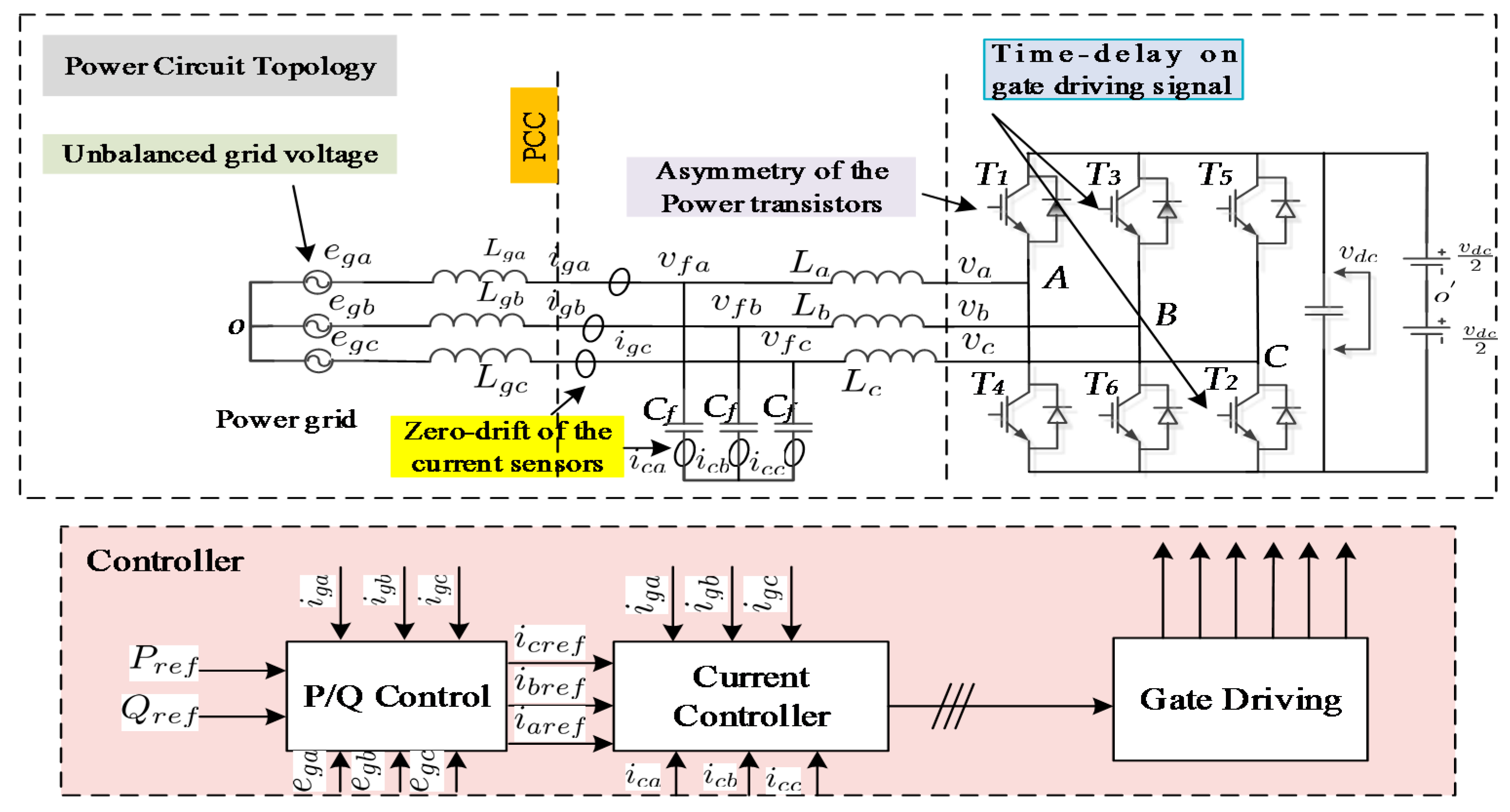

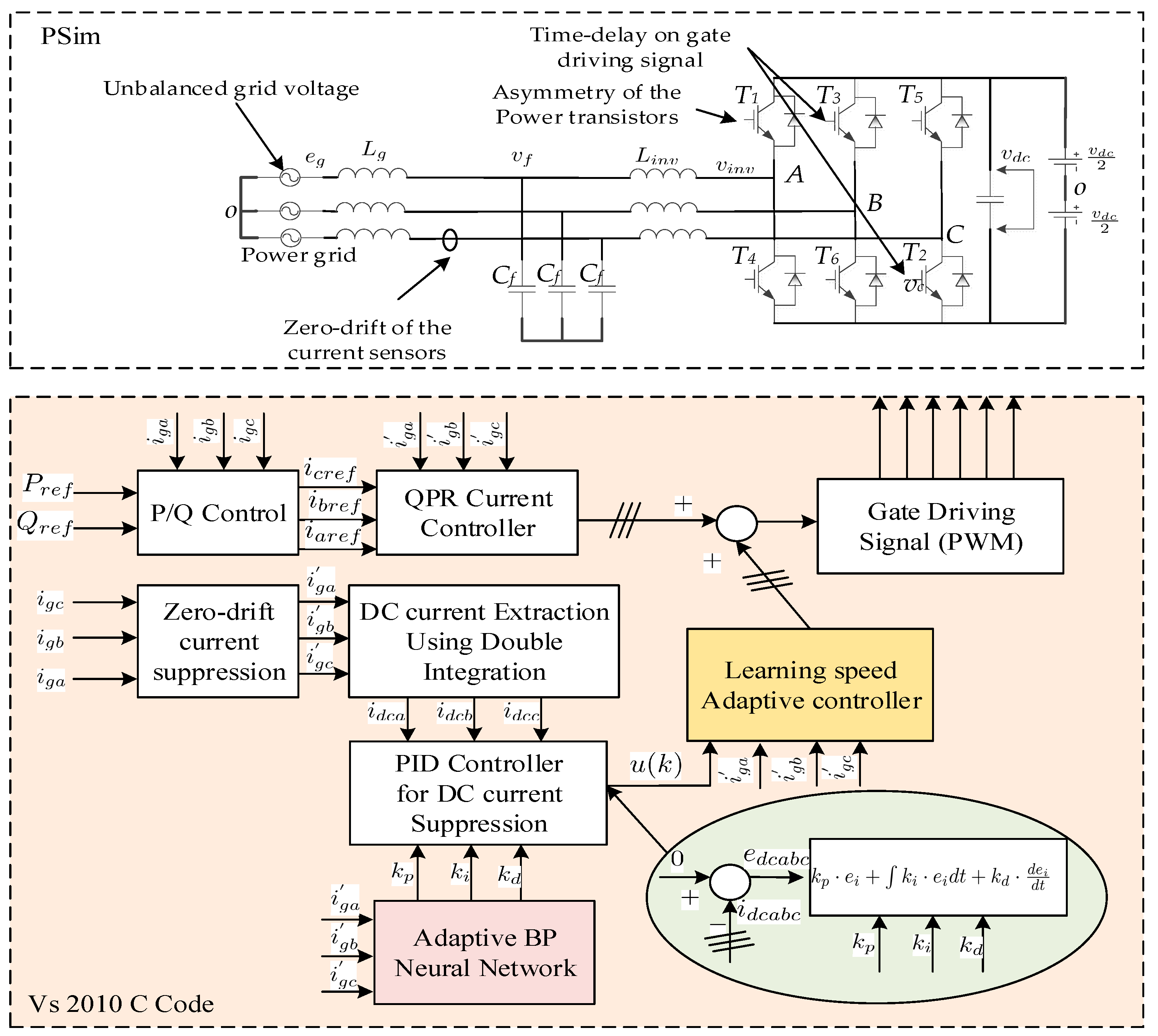
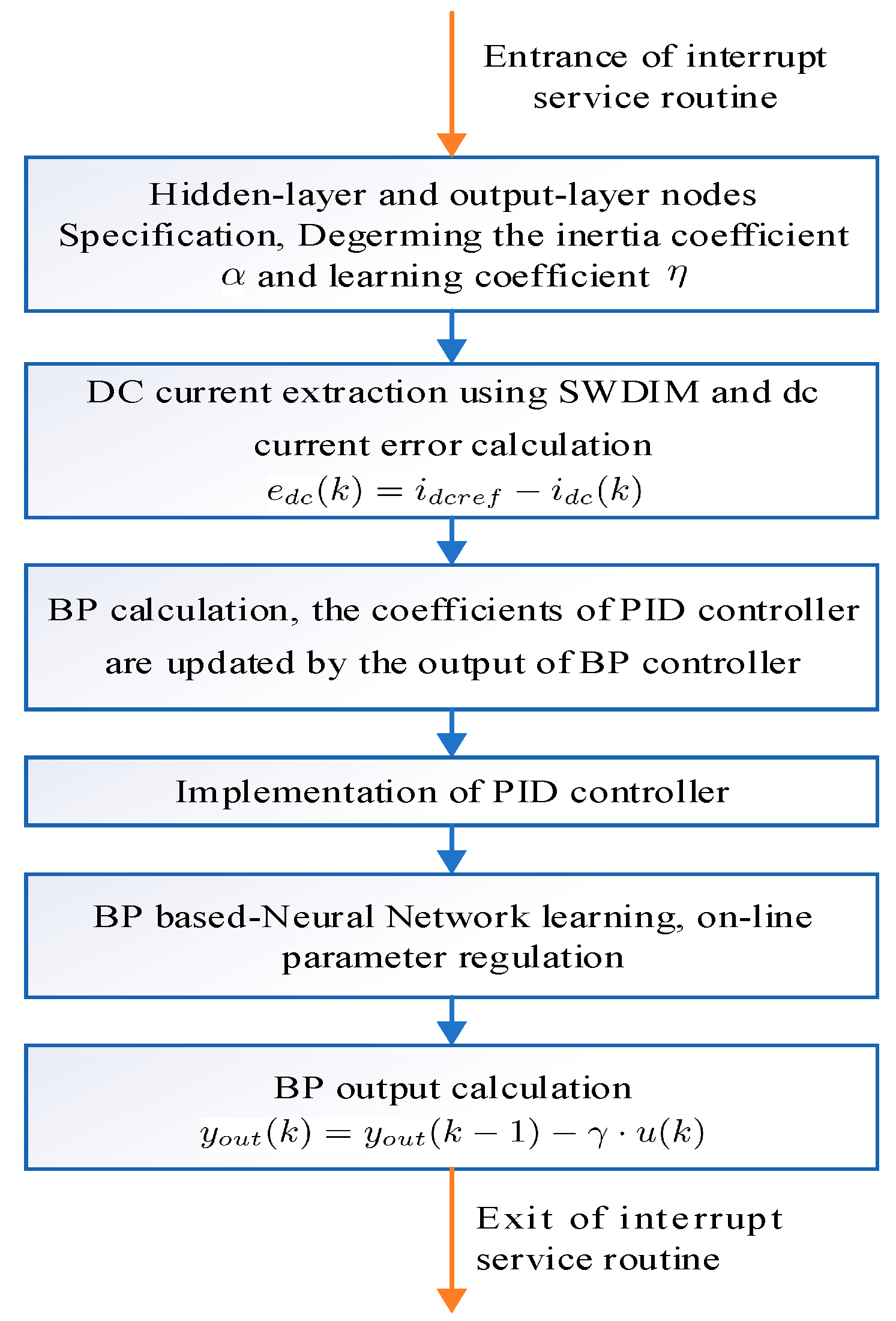
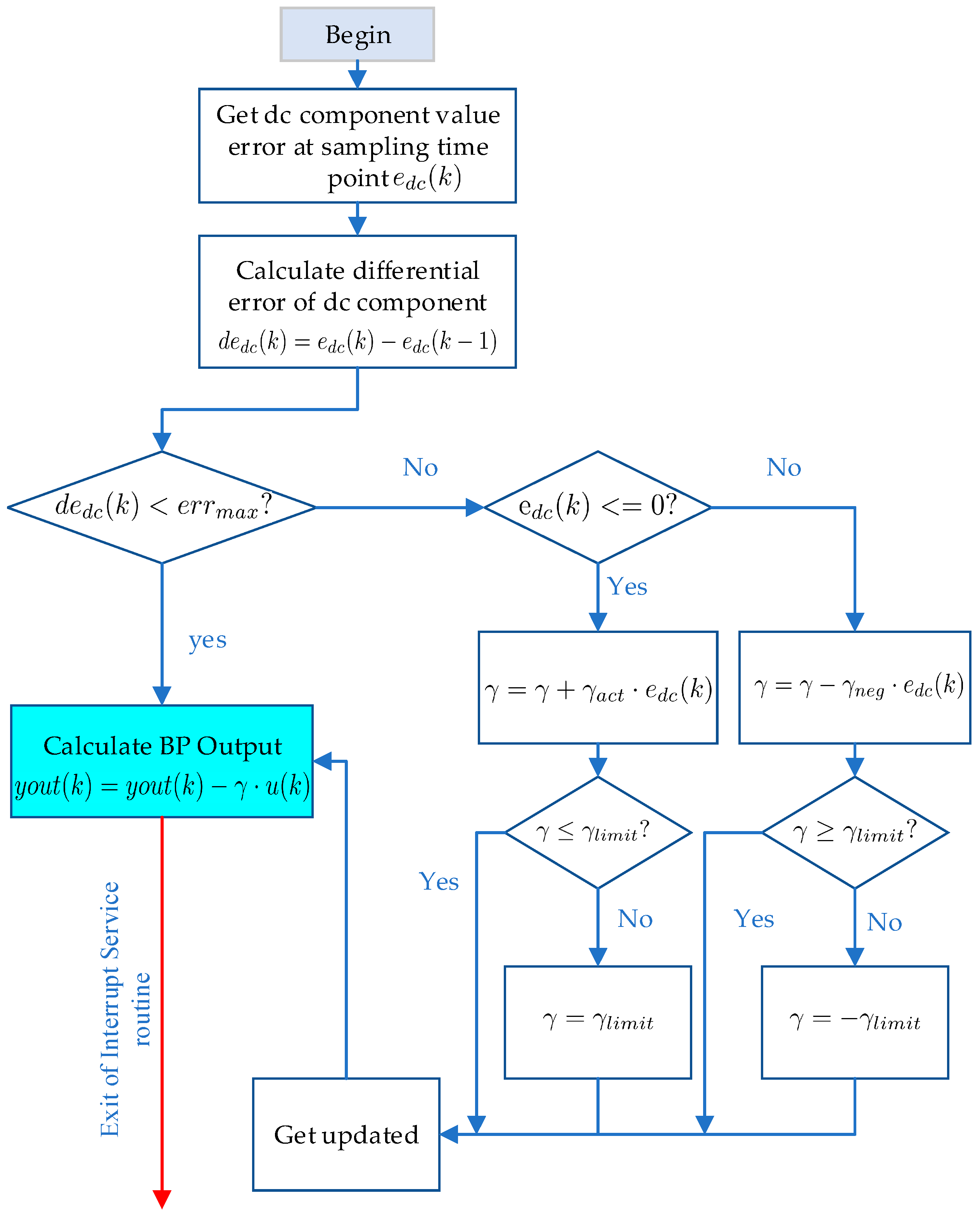
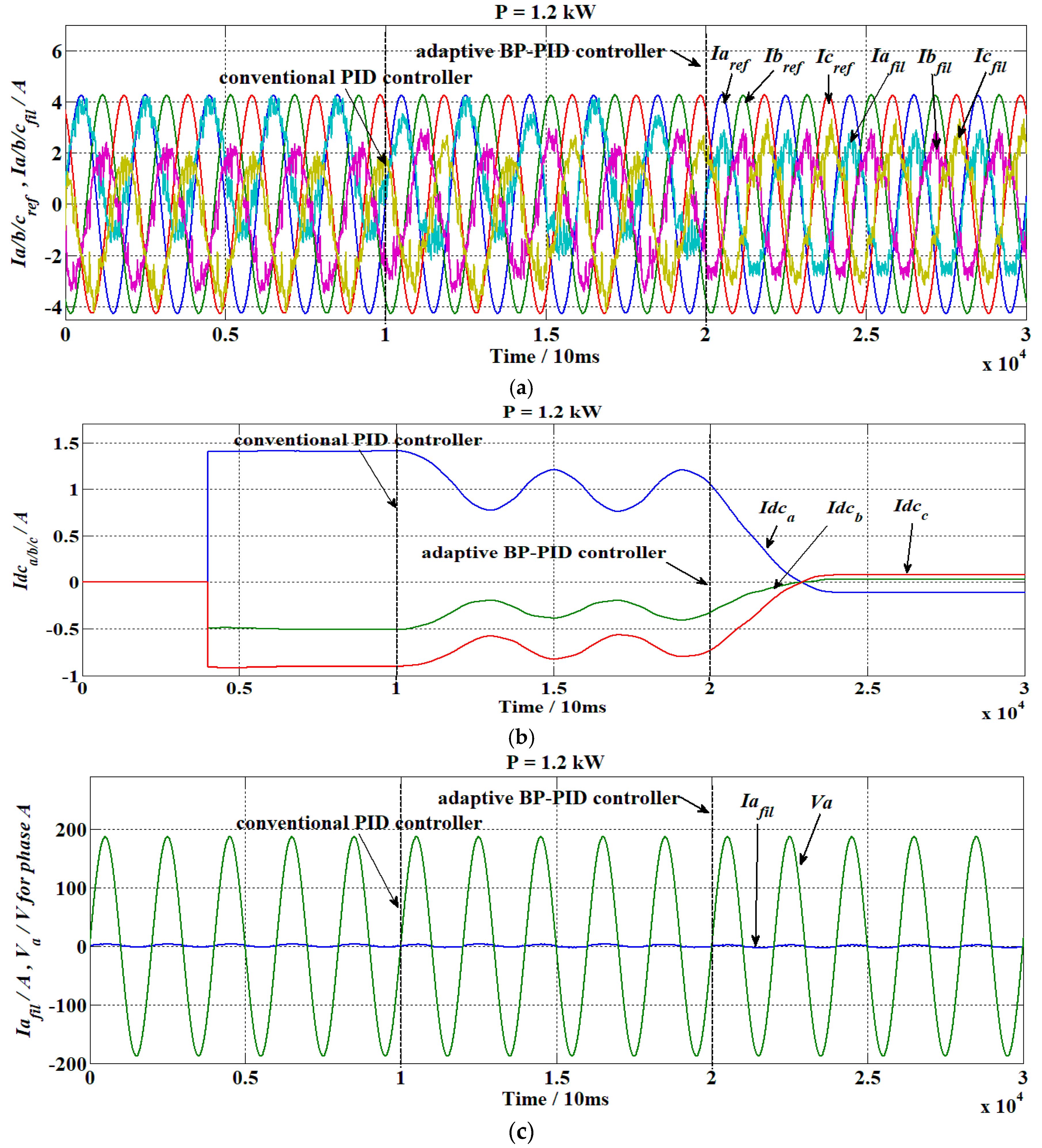
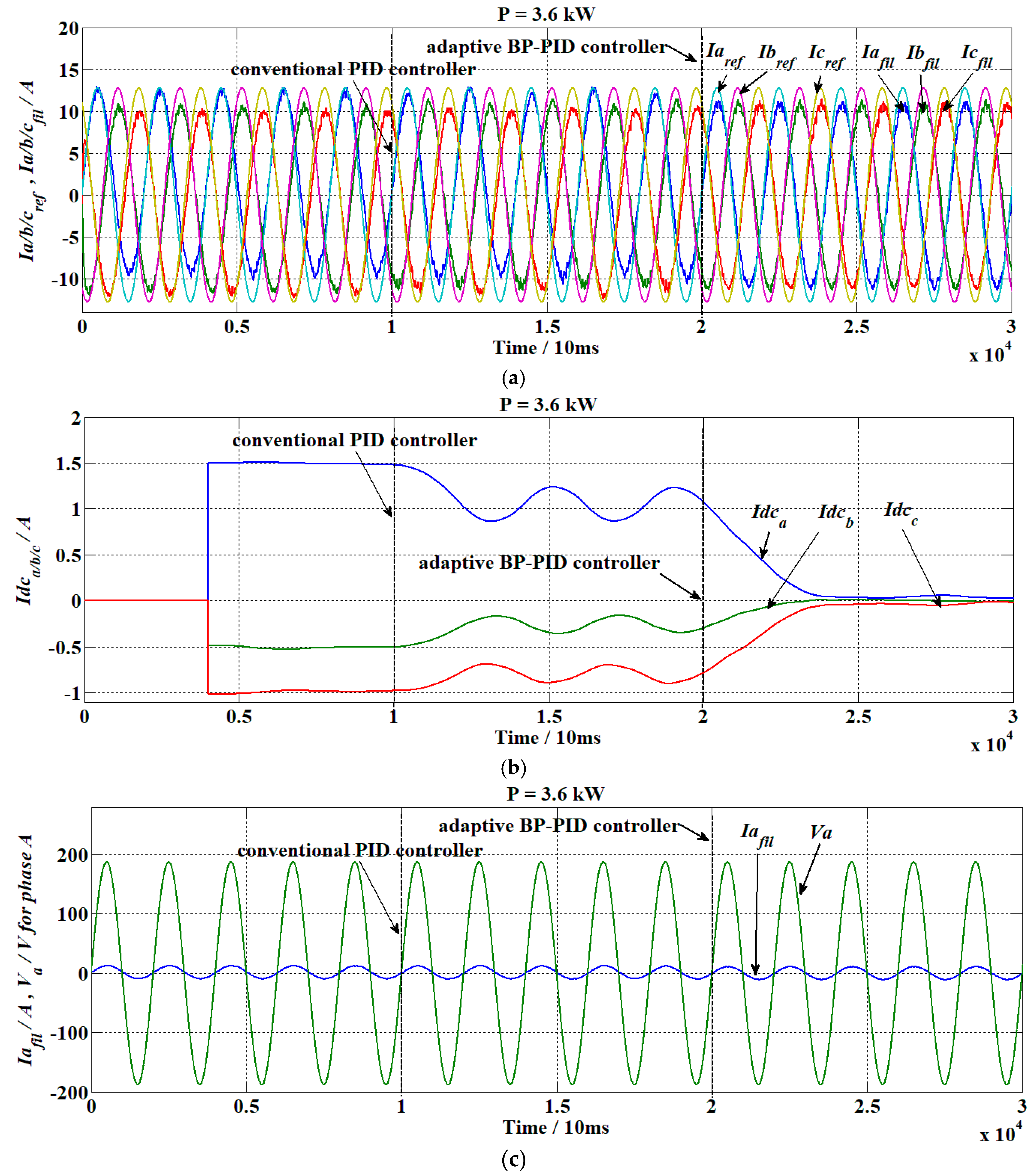

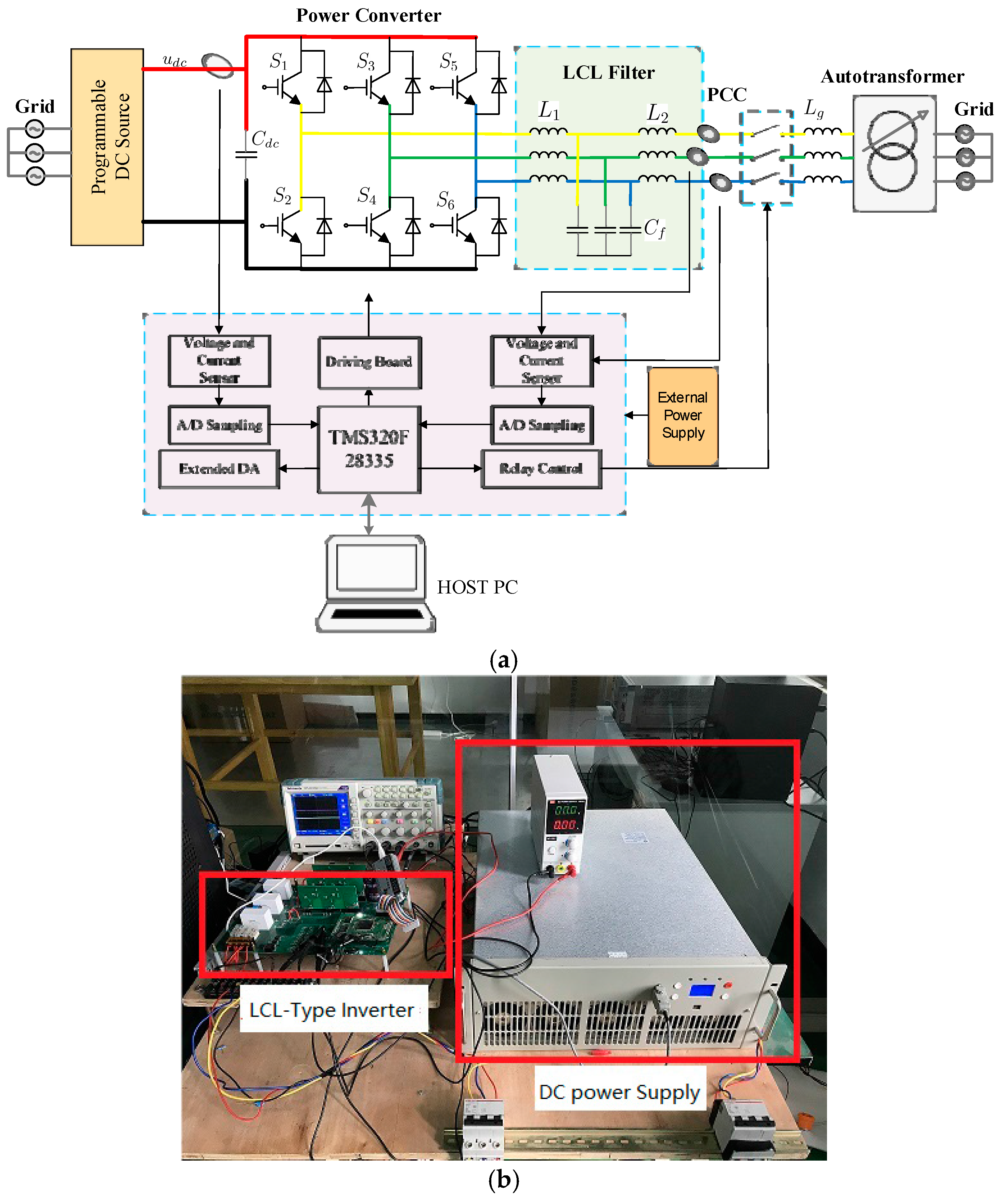
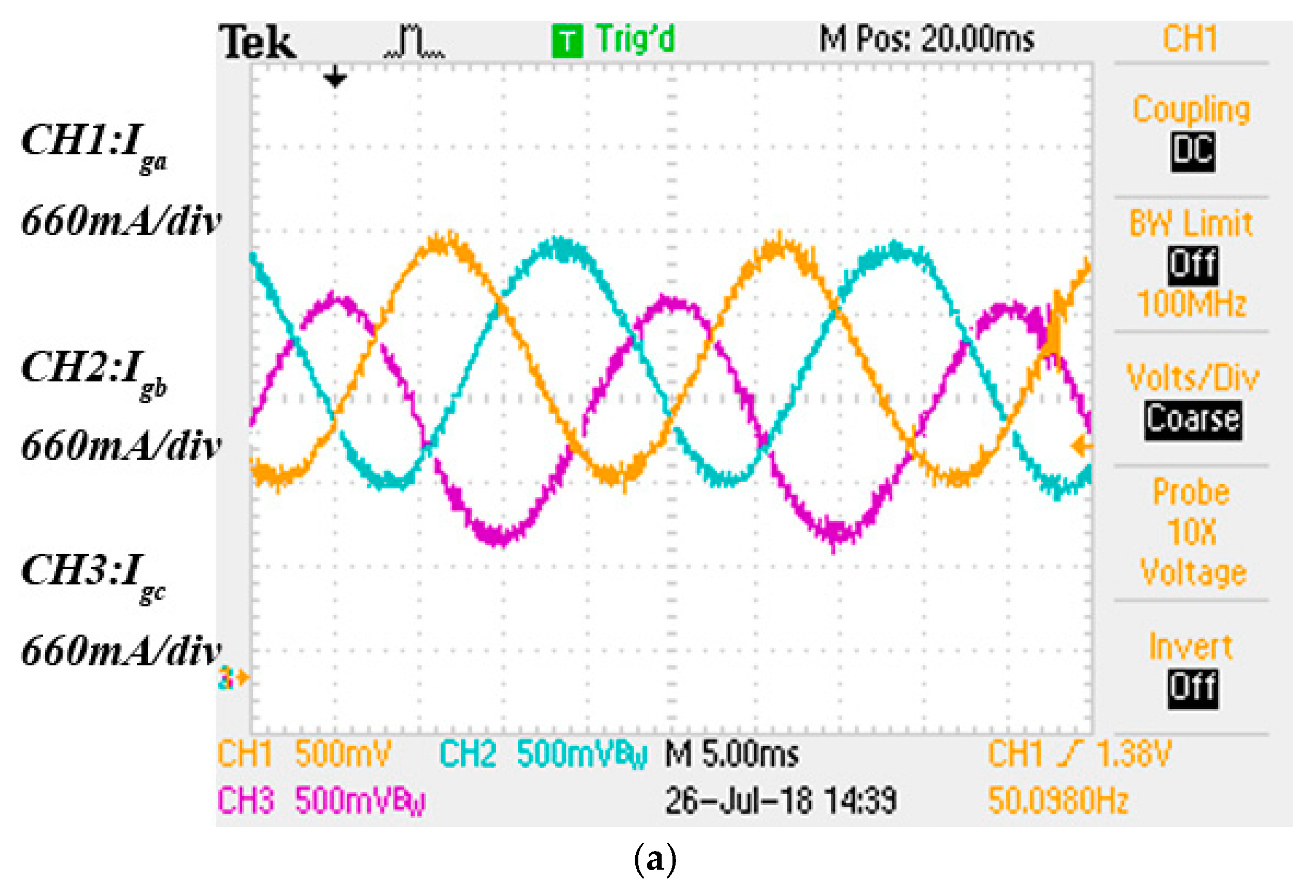
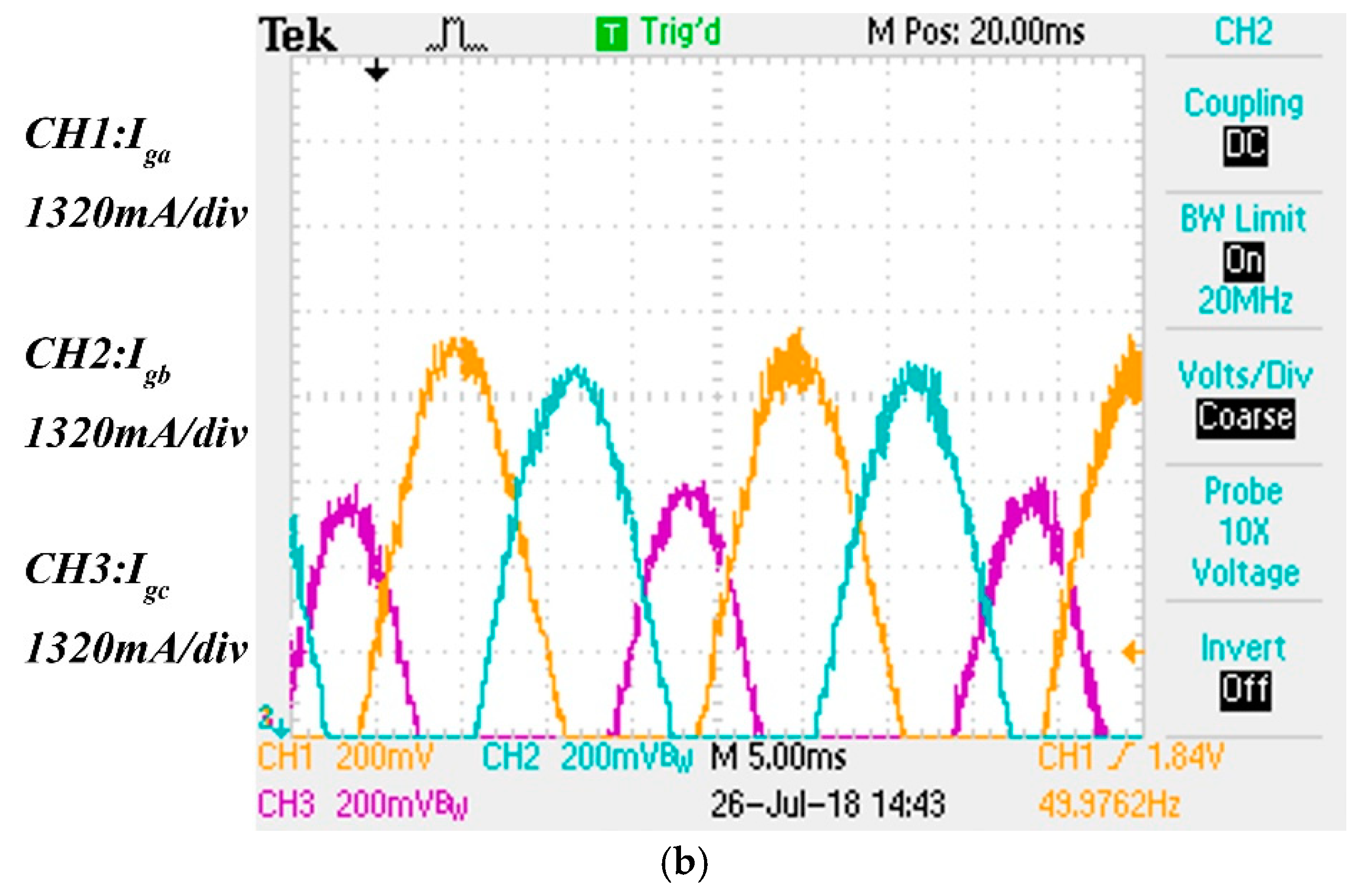
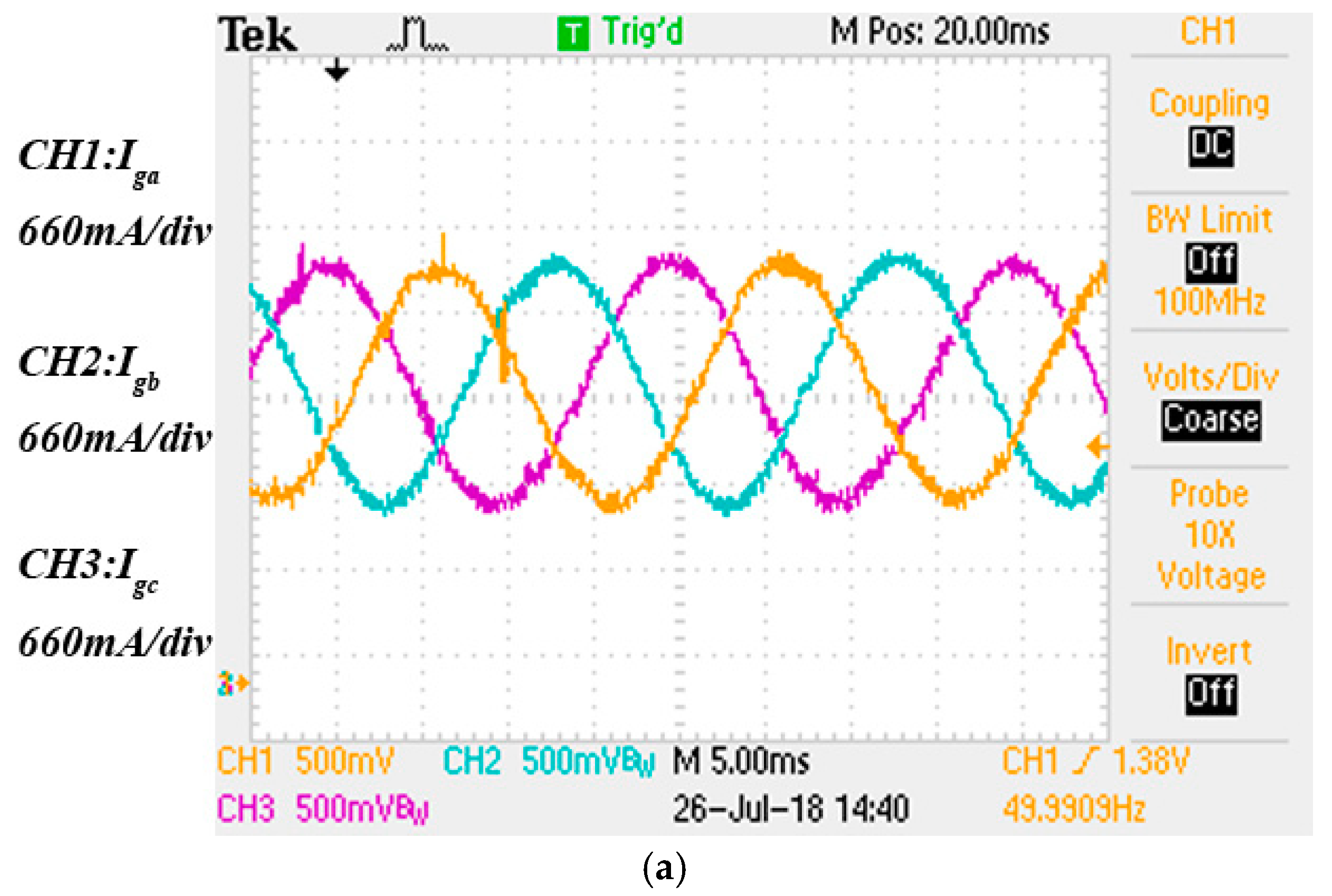
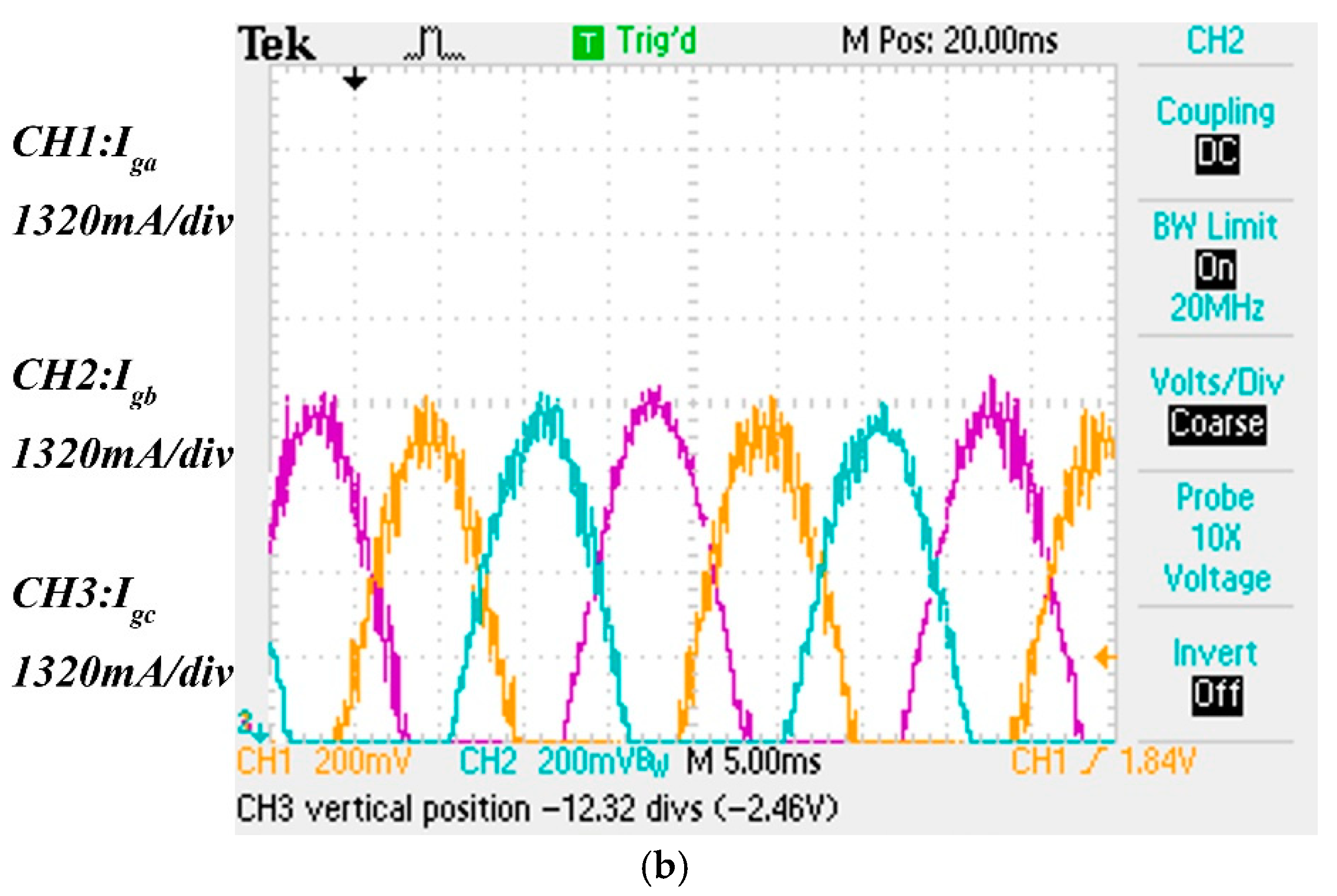
| Component | Parameter | Value |
|---|---|---|
| Grid | Grid voltage (line to line) | |
| Grid frequency | ||
| DC-link voltage | ||
| Switching frequency | ||
| Grid-side inductance | ||
| Inverter-side inductance | ||
| Capacitance of LCL filter |
| Symbol | Parameter | Values |
|---|---|---|
| Rated power | ||
| Line-to-Line voltage (After the autotransformer) | ||
| Grid frequency | ||
| DC-link capacitance | ||
| Inverter-side inductance | ||
| Grid-side inductance | ||
| Filter capacitance | ||
| Switching frequency | ||
| DC-link voltage |
| Three-Phase Currents | Harmonics Order | THD | |||||||||||
|---|---|---|---|---|---|---|---|---|---|---|---|---|---|
| DC | 1 | 2 | 3 | 4 | 5 | 6 | 7 | 8 | 9 | 10 | |||
| iga | Current value (A)% of fundamental | 19.1 | 100 | 2.10 | 1.67 | 0.57 | 0.90 | 0.65 | 1.28 | 0.73 | 0.36 | 1.75 | 7.68 |
| igb | Current value (A)% of fundamental | 14.3 | 100 | 2.12 | 1.51 | 0.63 | 0.43 | 0.99 | 0.58 | 0.63 | 0.52 | 0.46 | 6.81 |
| igc | Current value (A)% of fundamental | 33.4 | 100 | 3 | 0.25 | 1.03 | 1.20 | 0.4 | 0.38 | 0.61 | 0.78 | 1.39 | 8.13 |
| Three-Phase Currents | Harmonics Order | THD | |||||||||||
|---|---|---|---|---|---|---|---|---|---|---|---|---|---|
| DC | 1 | 2 | 3 | 4 | 5 | 6 | 7 | 8 | 9 | 10 | |||
| iga | Current value (A)% of fundamental | 0.19 | 100 | 1.33 | 0.81 | 0.39 | 1.90 | 0.85 | 0.72 | 0.67 | 0.24 | 0.15 | 6.52 |
| igb | Current value (A)% of fundamental | 4.32 | 100 | 1.91 | 1.46 | 0.84 | 0.65 | 0.92 | 0.92 | 0.82 | 1.19 | 0.44 | 6.38 |
| igc | Current value (A)% of fundamental | 3.17 | 100 | 1.72 | 1.16 | 1.38 | 0.73 | 0.52 | 0.25 | 0.22 | 0.69 | 0.34 | 5.87 |
© 2018 by the authors. Licensee MDPI, Basel, Switzerland. This article is an open access article distributed under the terms and conditions of the Creative Commons Attribution (CC BY) license (http://creativecommons.org/licenses/by/4.0/).
Share and Cite
Bo, L.; Huang, L.; Dai, Y.; Lu, Y.; To Chong, K. Mitigation of DC Components Using Adaptive BP-PID Control in Transformless Three-Phase Grid-Connected Inverters. Energies 2018, 11, 2047. https://doi.org/10.3390/en11082047
Bo L, Huang L, Dai Y, Lu Y, To Chong K. Mitigation of DC Components Using Adaptive BP-PID Control in Transformless Three-Phase Grid-Connected Inverters. Energies. 2018; 11(8):2047. https://doi.org/10.3390/en11082047
Chicago/Turabian StyleBo, Long, Lijun Huang, Yufei Dai, Youliang Lu, and Kil To Chong. 2018. "Mitigation of DC Components Using Adaptive BP-PID Control in Transformless Three-Phase Grid-Connected Inverters" Energies 11, no. 8: 2047. https://doi.org/10.3390/en11082047
APA StyleBo, L., Huang, L., Dai, Y., Lu, Y., & To Chong, K. (2018). Mitigation of DC Components Using Adaptive BP-PID Control in Transformless Three-Phase Grid-Connected Inverters. Energies, 11(8), 2047. https://doi.org/10.3390/en11082047





